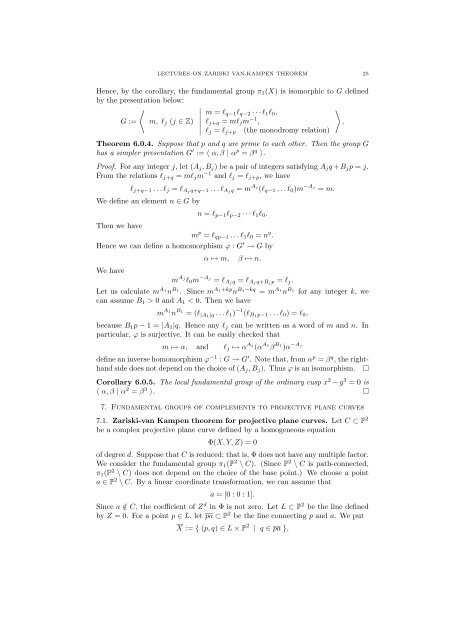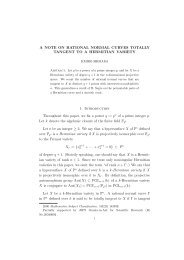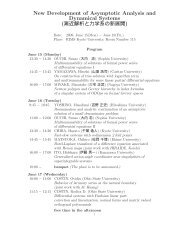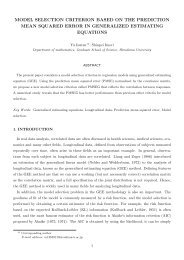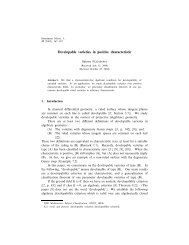LECTURES ON ZARISKI VAN-KAMPEN THEOREM 1. Introduction ...
LECTURES ON ZARISKI VAN-KAMPEN THEOREM 1. Introduction ...
LECTURES ON ZARISKI VAN-KAMPEN THEOREM 1. Introduction ...
You also want an ePaper? Increase the reach of your titles
YUMPU automatically turns print PDFs into web optimized ePapers that Google loves.
<strong>LECTURES</strong> <strong>ON</strong> <strong>ZARISKI</strong> <strong>VAN</strong>-<strong>KAMPEN</strong> <strong>THEOREM</strong> 25<br />
Hence, by the corollary, the fundamental group π 1 (X) is isomorphic to G defined<br />
by the presentation below:<br />
〈<br />
m = l q−1 l q−2 ···l 1 l 0 ,<br />
〉<br />
G := m, l j (j ∈ Z)<br />
l j+q = ml j m −1 ,<br />
.<br />
∣ l j = l j+p (the monodromy relation)<br />
Theorem 6.0.4. Suppose that p and q are prime to each other. Then the group G<br />
has a simpler presentation G ′ := 〈 α, β | α p = β q 〉.<br />
Proof. For any integer j, let (A j ,B j ) be a pair of integers satisfying A j q + B j p = j.<br />
From the relations l j+q = ml j m −1 and l j = l j+p , we have<br />
l j+q−1 ...l j = l Ajq+q−1 ...l Ajq = m Aj (l q−1 ...l 0 )m −Aj = m.<br />
We define an element n ∈ G by<br />
n = l p−1 l p−2 ···l 1 l 0 .<br />
Then we have<br />
m p = l qp−1 ...l 1 l 0 = n q .<br />
Hence we can define a homomorphism ϕ : G ′ → G by<br />
α ↦→ m, β ↦→ n.<br />
We have<br />
m Aj l 0 m −Aj = l Ajq = l Ajq+B jp = l j .<br />
Let us calculate m A1 n B1 . Since m A1+kp n B1−kq = m A1 n B1 for any integer k, we<br />
can assume B 1 > 0 and A 1 < 0. Then we have<br />
m A1 n B1 =(l |A1|q ...l 1 ) −1 (l B1p−1 ...l 0 )=l 0 ,<br />
because B 1 p − 1=|A 1 |q. Hence any l j can be written as a word of m and n. I n<br />
particular, ϕ is surjective. It can be easily checked that<br />
m ↦→ α, and l j ↦→ α Aj (α A1 β B1 )α −Aj<br />
define an inverse homomorphism ϕ −1 : G → G ′ . Note that, from α p = β q , the righthand<br />
side does not depend on the choice of (A j ,B j ). Thus ϕ is an isomorphism.<br />
Corollary 6.0.5. The local fundamental group of the ordinary cusp x 2 − y 3 =0is<br />
〈 α, β | α 2 = β 3 〉.<br />
7. Fundamental groups of complements to projective plane curves<br />
7.<strong>1.</strong> Zariski-van Kampen theorem for projective plane curves. Let C ⊂ P 2<br />
be a complex projective plane curve defined by a homogeneous equation<br />
Φ(X, Y, Z) =0<br />
of degree d. Suppose that C is reduced; that is, Φ does not have any multiple factor.<br />
We consider the fundamental group π 1 (P 2 \ C). (Since P 2 \ C is path-connected,<br />
π 1 (P 2 \ C) does not depend on the choice of the base point.) We choose a point<br />
a ∈ P 2 \ C. By a linear coordinate transformation, we can assume that<br />
a =[0:0:1].<br />
Since a/∈ C, the coefficient of Z d in Φ is not zero. Let L ⊂ P 2 be the line defined<br />
by Z = 0. For a point p ∈ L, let pa ⊂ P 2 be the line connecting p and a. We put<br />
X := { (p, q) ∈ L × P 2 | q ∈ pa },


